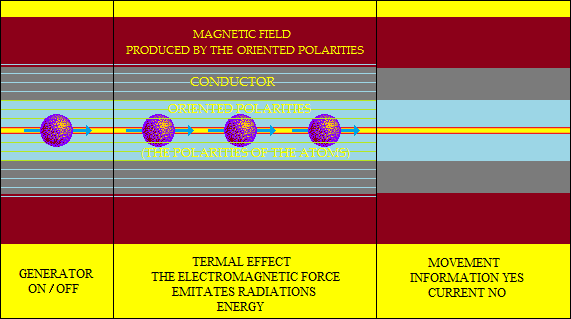Electric
current with vector interpretation
The vectorial currents are only and only the vectors properties and nothing
else!
It is impossible to perceive the vector's constitution in the absence
of information other than its properties.
The same limited definition is found under the name "electric charge,
with the exception that the vector is "decapitated, the positive
head independent of the negative tail".
In hydrogen atoms (double torr oscillators),
the currents with vector properties "dress" the first and the
only material form of solid body.
And the currents connecting atoms have solid properties.
The vectorial current is the same in space, in liquid and in solid - a
simple "corridor" of vectors inserted.
The solid conductor is a crystal, a structure of atoms, of vector oscillators
linked through their polarities.
The electrical current is a state of equilibrium in the crystal, between
the forces of the atoms in the crystal and the polarities of the atoms
oriented longitudinally by the electromagnetic force
around the conductor, which oppose the forces in the crystal to return
to the initial condition.
(the induced current always opposed to the cause that produced it)
The ratio of these forces results in the conductivity of the crystal,
and the conductivity, the current, shows the density of the oriented polarities,
depending on the electromagnetic force (voltage U), I respectively, increases
proportionally to U.
The corridor of oriented polarities, called improper current, is the
environment through
which information is propagated in the form of disruption of this equilibrium,
such as waves on the surface of a luster of water.
In the electric circuits, it is not the current that passes through, but
the information.
In batteries and capacitors are charged and discharged polarities orientation.
In Faraday's generator, the variable magnetic field is the electromagnetic
force
that orientates the polarities of the atoms in the conductor.
Oriented polarities unite the magnetism around them, and magnetism and
oriented polarities produce electromagnetic force, and the phenomenon
of the generator is repeated throughout the network.
The electromagnetic force is not transported but it exists simultaneously
with the operation of the generator, so that at any moment, at any point
of the network becomes the generator's load.
The intensity of the "current" is the density of the oriented
polarities,

